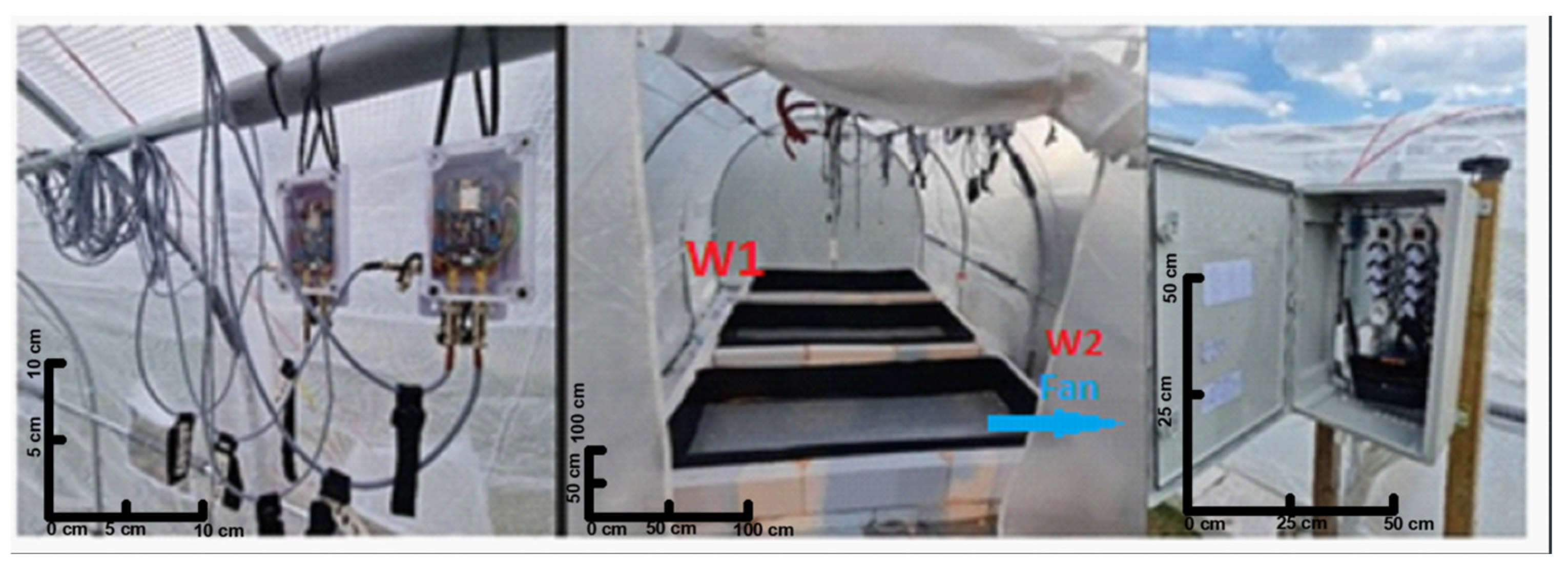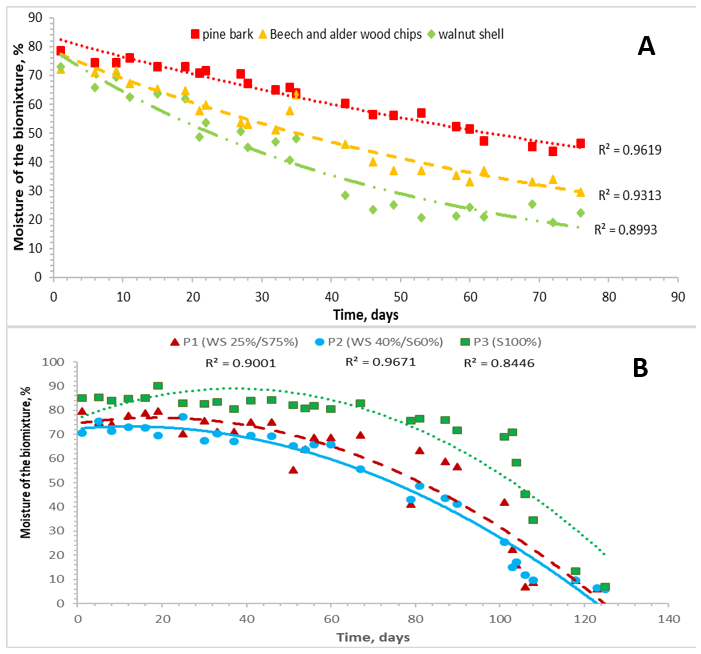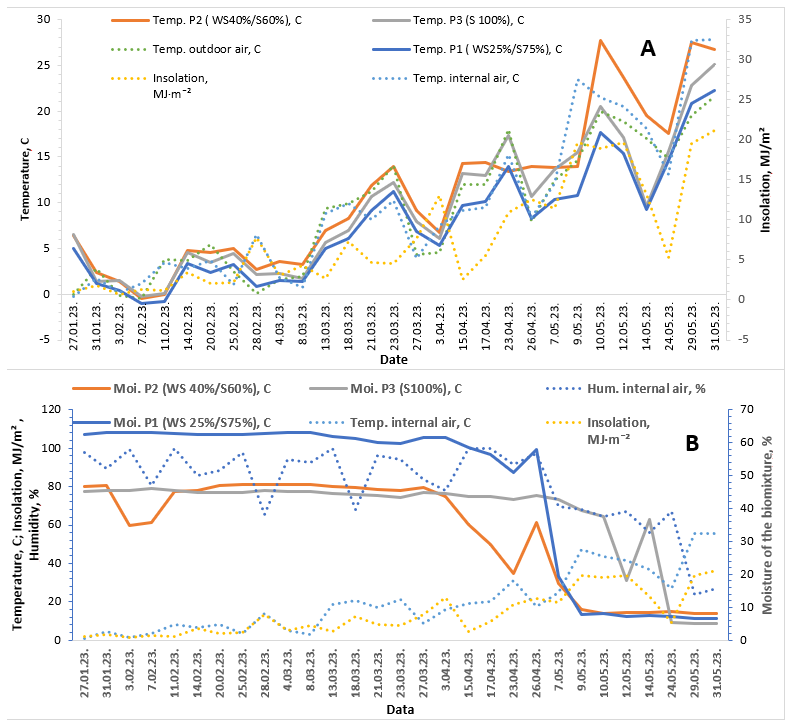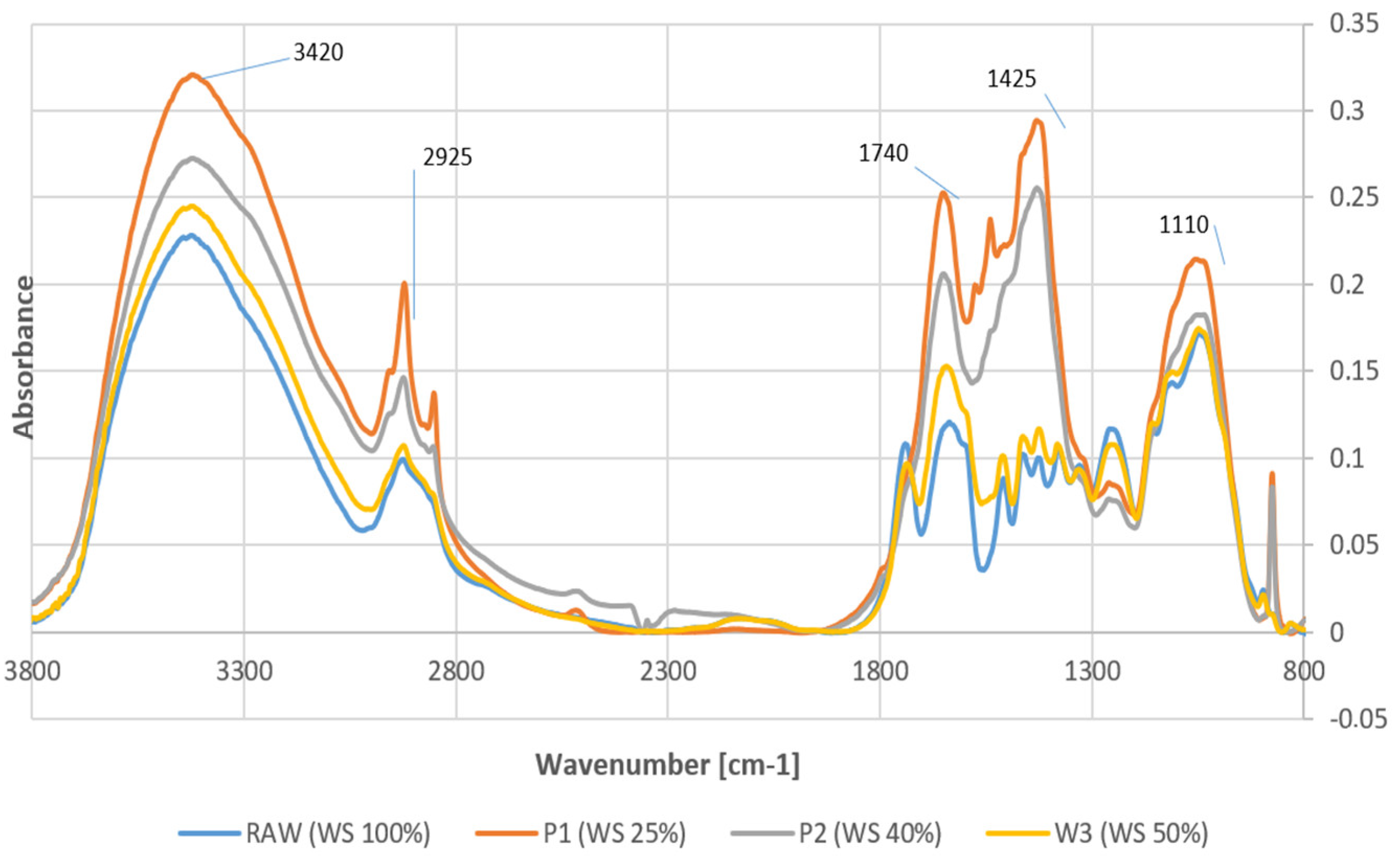The Influence of Drying Sewage Sludge with the Addition of Walnut Shells on Changes in the Parameters and Chemical Composition of the Mixture
Abstract
:1. Introduction
2. Materials and Methods
2.1. Physical and Chemical Analyses
2.1.1. Moisture Content and Organic Dry Matter Content of Biomixtures 3—Drying Curve
2.1.2. Analysis of the Breaking Strength of Walnut Shells
2.1.3. Walnut Shell Chemical Composition
2.1.4. Exhaust Gas and Element Analyses
2.1.5. Statistical Analysis
3. Results
3.1. Technological Parameters of Sewage Sludge Drying
3.1.1. Mechanical Crushing Strength of Walnut Shells
3.1.2. Walnut Shell Chemical Composition
4. Discussion
5. Conclusions
6. Patents
Author Contributions
Funding
Data Availability Statement
Acknowledgments
Conflicts of Interest
References
- Cieślik, B.M.; Namieśnik, J.; Konieczka, P. Review of sewage sludge management: Standards, regulations and analytical methods. J. Clean. Prod. 2015, 90, 1–15. [Google Scholar] [CrossRef]
- Werle, S. Sewage Sludge-To-Energy Management in Eastern Europe: A Polish Perspective. Ecol. Chem. Eng. 2015, 223, 459–469. [Google Scholar] [CrossRef]
- Przydatek, G.; Wota, A.K. Analysis of the comprehensive management of sewage sludge in Poland. J. Mater. Cycles Waste Manag. 2020, 22, 80–88. [Google Scholar] [CrossRef]
- Council Directive of 21 May 1991 Concerning Urban Waste Water Treatment (91/271/EEC) the Council of the European Communities. Available online: https://eur-lex.europa.eu/legal-content/EN/TXT/?uri=celex%3A31991L0271 (accessed on 8 August 2024).
- Directive 2009/28/EC of the European Parliament and of the Council of 23 April 2009 on the Promotion of the Use of Energy from Renewable Sources. Available online: https://eur-lex.europa.eu/eli/dir/2009/28/oj (accessed on 8 August 2024).
- Directive (EU) 2018/851 of the European Parliament and of the Council of 30 May 2018 Amending Directive 2008/98/EC on Waste. Available online: https://eur-lex.europa.eu/eli/dir/2018/851/oj (accessed on 8 August 2024).
- Proposal for a Directive of the European Parliament and of the Council Concerning Urban Wastewater Treatment. 26 October 2022. Available online: https://eur-lex.europa.eu/legal-content/EN/TXT/?uri=CELEX%3A52022PC0541 (accessed on 8 August 2024).
- Bałazińska, M.; Markowska, M.; Blaut, A.; Głodniok, M. Life Cycle Assessment of Eco-Innovative Organo-Mineral Granulated Fertilizer’s Production Technology. Rocz. Ochr. Sr. 2020, 22, 561–588. [Google Scholar]
- Hurynovich, A.; Kwietniewski, M.; Romanovski, V. Evaluation of the possibility of utilization of sewage sludge from a wastewater treatment plant-case study. Desalin. Water Treat. 2021, 227, 16–25. [Google Scholar] [CrossRef]
- Piechota, G.; Igliński, B. Biomethane in Poland—Current Status, Potential, Perspective and Development. Energies 2021, 14, 1517. [Google Scholar] [CrossRef]
- Posligua, P.; Peñaherrera, M.; Villegas, E.; Banchón, C. Gravimetric Evolution During Sewage Sludge Biostabilization. J. Ecol. Eng. 2018, 195, 76–85. [Google Scholar] [CrossRef]
- Możdżer, E. Effect of Fertilization with Sludge-Ash Granulates on the Activity of Selected Soil Enzymes. J. Ecol. Eng. 2022, 234, 137–144. [Google Scholar] [CrossRef]
- Hajji, S.; Ben-Haddad, M.; Rida Abelouah, M.; De-la-Torre, G.E.; Ait Alla, A. Sludge drying and dewatering processes influence the abundance and characteristics of microplastics in wastewater treatment plants. Chemosphere 2023, 339, 139743. [Google Scholar] [CrossRef]
- Kosiński, P.; Kask, B.; Franus, M.; Piłat-Rożek, M.; Szulżyk-Cieplak, J.; Łagód, G. The Possibility of Using Sewage Sludge Pellets as Thermal Insulation. Adv. Sci. Technol. Res. J. 2023, 172, 161–172. [Google Scholar] [CrossRef]
- Mehrdadi, N.; Joshi, S.G.; Nasrabadi, T.; Hoveidi, H. Aplication of solar energy for drying of sludge from pharmaceutical industrial waste water and probable reuse. Int. J. Environ. Res. 2007, 1, 42–48. [Google Scholar]
- Khan, R.; Shukla, S.; Kumar, M.; Zuorro, A.; Pandey, A. Sewage sludge derived biochar and its potential for sustainable environment in circular economy: Advantages and challenges. J. Chem. Eng. 2023, 471, 144495. [Google Scholar] [CrossRef]
- Zhen, G.; Lu, X.; Kato, H.; Zhao, Y.; Li, Y.Y. Overview of pretreatment strategies for enhancing sewage sludge disintegration and subsequent anaerobic digestion: Current advances, full-scale application and future perspectives. Renew. Sust. Energy Rev. 2017, 69, 559–577. [Google Scholar] [CrossRef]
- Cesaro, A.; Pirozzi, F.; Zafırakou, A.; Alexandraki, A. Microplastics in sewage sludge destined to anaerobic digestion: The potential role of thermal pretreatment. Chemosphere 2022, 309, 136669. [Google Scholar] [CrossRef]
- Yusuf, H.H.; Roddick, F.; Jegatheesan, V.; Gao, L.; Pramanik, B.K. Tackling fat, oil, and grease FOG build-up in sewers: Insights into deposit formation and sustainable in-sewer management techniques. Sci. Total Environ. 2023, 904, 166761. [Google Scholar] [CrossRef]
- Jat Baloch, M.Y.; Zhang, W.; Sultana, T.; Akram, M.; Shoumik, B.A.; Al Khan, M.Z.; Farooq, M.A. Utilization of sewage sludge to manage saline–alkali soil and increase crop production: Is it safe or not? Environ. Technol. Innov. 2023, 32, 103266. [Google Scholar] [CrossRef]
- Syed-Hassan, S.S.A.; Wang, Y.; Hu, S.; Su, S.; Xiang, J. Thermochemical processing of sewage sludge to energy and fuel: Fundamentals, challenges and considerations. Renew. Sustain. Energy Rev. 2017, 80, 888–913. [Google Scholar] [CrossRef]
- An-nori, A.; El Fels, L.; Ezzariai, A.; El Gharous, M.; El Mejahed, K.; Hafidi, M. Effects of solar drying on heavy metals availability and phytotoxicity in municipal sewage sludge under semi-arid climate. Environ. Technol. Innov. 2020, 19, 101039. [Google Scholar] [CrossRef]
- Fan, Z.; Zhou, X.; Peng, Z.; Wan, S.; Gao, Z.F.; Deng, S.; Tong, L.; Han, W.; Chen, X. Co-pyrolysis technology for enhancing the functionality of sewage sludge biochar and immobilizing heavy metals. Chemosphere 2023, 317, 137929. [Google Scholar] [CrossRef]
- Krawczyk, P. Numerical Modeling of Simultaneous Heat and Moisture Transfer During Sewage Sludge Drying in Solar Dryer. Procedia Eng. 2016, 157, 230–237. [Google Scholar] [CrossRef]
- Kossińska, N.; Krzyżyńska, R.; Ghazal, H.; Jouhara, H. Hydrothermal carbonisation of sewage sludge and resulting biofuels as a sustainable energy source. Energy 2023, 275, 127337. [Google Scholar] [CrossRef]
- Kowalczyk-Juśko, A.; Mazur, K.; Maciąg, M.; Pochwatka, P.; Listosz, A.; Mazur, A. Estimation of Potential of Agriculture Biogas Production in Biała Podlaska County Poland. J. Ecol. Eng. 2020, 218, 156–162. [Google Scholar] [CrossRef] [PubMed]
- Piboonudomkarn, S.; Khemthong, P.; Youngjan, S.; Wantala, K.; Tanboonchuy, V.; Lubphoo, Y.; Khunphonoi, R. Co-hydrothermally carbonized sewage sludge and lignocellulosic biomass: An efficiently renewable solid fuel. Arab. J. Chem. 2023, 1612, 105315. [Google Scholar] [CrossRef]
- Wzorek, M. Solar drying of granulated waste blends for dry biofuel production. Environ. Sci. Pollut. Res. 2021, 2826, 34290–34299. [Google Scholar] [CrossRef]
- Smol, M. Inventory of Wastes Generated in Polish Sewage Sludge Incineration Plants and Their Possible Circular Management Directions. Resources 2020, 9, 91. [Google Scholar] [CrossRef]
- Boguniewicz-Zablocka, J.; Klosok-Bazan, I.; Capodaglio, A.G. Sustainable management of biological solids in small treatment plants: Overview of strategies and reuse options for a solar drying facility in Poland. Environ. Sci. Pollut. Res. Int. 2021, 2819, 24680. [Google Scholar] [CrossRef]
- Tańczuk, M.; Kostowski, W.; Karaś, M. Applying waste heat recovery system in a sewage sludge dryer—A technical and economic optimization. Energy Convers. Manag. 2016, 125, 121–132. [Google Scholar] [CrossRef]
- Krawczyk, P. Control strategy for ventilation system of sewage sludge solar dryer. J. Power Technol. 2016, 96, 145–148. [Google Scholar]
- Czekała, W.; Dach, J.; Janczak, D.; Smurzyńska, A.; Kwiatkowska, A.; Kozłowski, K. Influence of maize straw content with sewage sludge on composting process. J. Water Land. Dev. 2016, 301, 43–49. [Google Scholar] [CrossRef]
- Czekała, W.; Nowak, M.; Piechota, G. Sustainable management and recycling of anaerobic digestate solid fraction by composting: A review. Bioresour. Technol. 2023, 375, 128813. [Google Scholar] [CrossRef]
- Matias Gonçalves, L.; Mendoza-Martinez, C.; Alves Rocha, E.P.; Coutinho de Paula, E.; Cardoso, M. Solar Drying of Sludge from a Steel-Wire-Drawing Industry. Energies 2023, 16, 6314. [Google Scholar] [CrossRef]
- Calín-Sánchez, Á.; Lipan, L.; Cano-Lamadrid, M.; Kharaghani, A.; Masztalerz, K.; Carbonell-Barrachina, Á.A.; Figiel, A. Comparison of Traditional and Novel Drying Techniques and Its Effect on Quality of Fruits. Veg. Aromat. Herbs Foods Basel. 2020, 9, 1261. [Google Scholar] [CrossRef]
- Mayanja, I.K.; Coates, M.C.; Niederholzer, F.; Donis-González, I.R. Drying of freshly harvested almonds using a stockpile heated and ambient air dryer SHAD with an air distributor-part 2. Biosyst. Eng. 2023, 235, 189–201. [Google Scholar] [CrossRef]
- Mhd Safri, N.A.; Zainuddin, Z.; Mohd Azmi, M.S.; Zulkifle, I.; Fudholi, A.; Ruslan, M.H.; Sopian, K. Current status of solar-assisted greenhouse drying systems for drying industry food materials and agricultural crops. Trends Food Sci. Technol. 2021, 114, 633–657. [Google Scholar] [CrossRef]
- Saini, R.K.; Saini, D.K.; Gupta, R.; Verma, P.; Thakur, R.; Kumar, S.; Wassouf, A. Technological development in solar dryers from 2016 to 2021—A review. Renew. Sust. Energy Rev. 2023, 188, 113855. [Google Scholar] [CrossRef]
- Lewandowski, W.M. Pro-Ecological Renewable Energy Sources; WNT: Warszawa, Poland, 2012. [Google Scholar]
- Afshari, F.; Khanlari, A.; Tuncer, A.D.; Sözen, A.; Şahinkesen, I.; Di Nicola, G. Dehumidification of sewage sludge using quonset solar tunnel dryer: An experimental and numerical approach. Renew. Energy 2021, 171, 784–798. [Google Scholar] [CrossRef]
- Getahun, E.; Delele, M.A.; Gabbiye, N.; Fanta, S.W.; Demissie, P.; Vanierschot, M. Importance of integrated CFD and product quality modeling of solar dryers for fruits and vegetables: A review. Sol. Energy 2021, 220, 466–468. [Google Scholar] [CrossRef]
- Horn, S.; Barr, K.; McLellan, J.; Bux, M. Accelerated Air Drying of Sewage Sludge Using a Climate Controlled Solar Drying Hall. 2020. Available online: https://www.thermo-system.com (accessed on 8 August 2024).
- Das, M.; Akpinar, E.K. Determination of thermal and drying performances of the solar air dryer with solar tracking system: Apple drying test. Case Stud. Therm. Eng. 2020, 21, 00731. [Google Scholar] [CrossRef]
- Karaağaç, M.O.; Ergün, A.; Ağbulut, Ü.; Gürel, A.E.; Ceylan, İ. Experimental analysis of CPV/T solar dryer with nano-enhanced PCM and prediction of drying parameters using ANN and SVM algorithms. Sol. Energy 2021, 218, 57–67. [Google Scholar] [CrossRef]
- Albatrni, H.; Qiblawey, H.; Al-Marri, M.J. Walnut shell based adsorbents: A review study on preparation, mechanism, and application. J. Water Process Eng. 2022, 45, 102527. [Google Scholar] [CrossRef]
- Seifert, K. Zur frage der cellulose-schnellbestimmung nach der acetylaceton-methode. Das Papier 1960, 14, 104–106. (In German) [Google Scholar]
- TAPPI T 9 wd-75; Holocellulose in Wood. Technical Association of the Pulp and Paper Industry (TAPPI): Atlanta, GA, USA, 2006.
- TAPPI T-222 om-06; Standard Methods for Acid Insoluble Lignin in Wood and Pulp. Technical Association of Pulp and Paper Industry: Atlanta, GA, USA, 2006.
- TAPPI T 204 cm-07; Solvent Extractives of Wood and Pulp. Technical Association of the Pulp and Paper Industry (TAPPI): Atlanta, GA, USA, 2007.
- DIN 51731:1996; Testing of Solid Fuels—Compressed and Untreated Wood—Requirements and Testing. German Institute for Standardization: Berlin, Germany, 1996.
- TAPPI-T 223 cm-01; Pentosans in Wood and Pulp. Technical Association of the Pulp and Paper Industry (TAPPI): Atlanta, GA, USA, 2001.
- PN-EN ISO 16994:2016; Solid Biofuels—Determination of Total Content of Sulfur and Chlorine. Polish Committee for Standarization: Warsaw, Poland, 2016.
- PN-EN ISO 18134-1; Solid Biofuels—Determination of Moisture Content—Oven Dry Method—Part 1: Total Moisture—Reference Method. Polski Komitet Normalizacyjny: Warszawa, Poland, 2016.
- PN-EN ISO 21663:2021-06; Solid Recovered Fuels—Determination of Total Content of Carbon, Hydrogen and Nitrogen. Polski Komitet Normalizacyjny: Warszawa, Poland, 2021.
- PN-EN ISO 21656:2021; Solid Recovered Fuels—Determination of Ash Content. Polski Komitet Normalizacyjny: Warszawa, Poland, 2021.
- PN-EN ISO 21654:2021-12; Solid Recovered Fuels—Determination of Calorific Value. Polski Komitet Normalizacyjny: Warszawa, Poland, 2021.
- PN-EN ISO 11885:2009; Water Quality—Determination of Selected Elements by Inductively Coupled Plasma Optical Emission Spectrometry (ICP-OES). Polski Komitet Normalizacyjny: Warszawa, Poland, 2009.
- Domingos, I.; Ferreira, J.; Cruz-Lopes, L.P.; Esteves, B. Liquefaction and chemical composition of walnut shells. Open Agric. 2022, 7, 249–256. [Google Scholar] [CrossRef]
- Prosiński, S. Chemia Drewna; PWRiL: Warszawa, Poland, 1984; ISBN 83-09-00674-8. [Google Scholar]
- Queirós, C.S.G.P.; Cardoso, S.; Lourenço, A.; Ferreira, J.; Miranda, I.; Lourenço, M.J.V.; Pereira, H. Characterization of walnut, almond, and pine nut shells regarding chemical composition and extract composition. Biomass Convers. Biorefin. 2020, 10, 175–188. [Google Scholar] [CrossRef]
- Queirós, C.S.G.P.; Cardoso, S.; Ferreira, J.; Miranda, I.; Lourenço, M.J.V.; Pereira, H. Characterization of Hakea sericea Fruits Regarding Chemical Composition and Extract Properties. Waste Biomass Valorization 2020, 11, 4859–4870. [Google Scholar] [CrossRef]
- Pirayesh, H.; Khazaeian, A.; Tabarsa, T. The potential for using walnut Juglans regia L. shell as a raw material for wood-based particleboard manufacturing. Compos. B Eng. 2012, 43, 32763280. [Google Scholar] [CrossRef]
- Pandey, K.K.; Pitman, A.J. FTIR studies of the changes in wood chemistry following decay by brown-rot and white-rot fungi. Int. Biodeterior. Biodegrad. 2003, 52, 151–160. [Google Scholar] [CrossRef]
- El Hadidi, N.M.N. Decay of softwood in archaeological wooden artifacts. Stud. Conserv. 2017, 62, 83–95. [Google Scholar] [CrossRef]
- PN-EN ISO 17225-7; Solid Biofuels—Fuel Specifications and Classes—Part 7: Graded Non-Woody Briquettes. Polski Komitet Normalizacyjny: Warszawa, Poland, 2021.
- Trojanowska, K. Economics of sewage sludge drying plants—A review of the first decade of Polish experience. Exploitator. Forum. 2016, 3, 56–63. [Google Scholar]
- Krawczyk, P. The relative change of drying rate as a function of thecumulative ventilation air drying potential in a thin-layer solar drying facility. IOP Conf. Ser. Mater. Sci. Eng. 2020, 556, 012055. [Google Scholar] [CrossRef]
- Makowska, M.; Kujawiak, S.; Pawlak, M.; Sowińska, A. Energy use of a biomixture based on sewage sludge. Assessment of sewage and sludge management. In Poland. Report. PAN Monographs of the Environmental Engineering Committee, 1st ed.; Bień, J., Gromiec, M., Pawłowski, L., Eds.; Committee of Environmental Engineering: Lublin, Poland, 2020; Issue 166. [Google Scholar]
- Zajemska, M.; Musiał, D. Energy use of biomass from agricultural production in co-combustion process. Probl. Agric. Eng. 2013, 4, 107–118. [Google Scholar]





| Name | Nitrogen Content, [% DM] | Carbon Content, [% DM] | Moisture, [%] | Bulk Density, [kg/dm3] | Dry Organic Matter Content, [% DM Org] |
|---|---|---|---|---|---|
| Beech-alder wood chips | 0.73 | 48.19 | 8.47 | 0.25 | 73.74 |
| Pine bark (sorted) | 1.13 | 50.06 | 52.05 | 0.15 | 65.01 |
| Walnut shells | 0.83 | 49.89 | 13.11 | 0.20 | 72.44 |
| Sewage sludge | 6.57 | 37.08 | 86.47 | 1.2 | 59.25 |
| Number Series | Period Start | Period Endings | Type of Mixture |
|---|---|---|---|
| Preliminary research | 7 September 2022 | 26 November 2022 | W1—Pine bark 50%/Sewage sludge 50% W2—Beech-alder chips 50%/Sewage sludge 50% W3—Walnut shells 50%/Sewage sludge 50% |
| Basic series | 26 January 2023 | 30 May 2023 | P1—Walnut shells 25%/Sewage sludge 75% P2—Walnut shells 40%/Sewage sludge 60% P3—Sewage sludge 100% |
| Parameter | Unit of Measurement | Survey Methodology |
|---|---|---|
| Total chlorine content | % s.m. | PN-EN ISO 16994:2016 [53] |
| Total moisture content | % | PN-EN ISO 18134-1 [54] |
| Total sulphur content | % d.m. | PN-EN ISO 21663:2021-06 [55] |
| Total hydrogen content | % d.m. | PN-EN ISO 21663:2021-06 [55] |
| Total carbon content | % d.m. | PN-EN ISO 21663:2021-06 [55] |
| Ash | % d.m. | PN-EN ISO 21656:2021-08 method A [56] |
| Heat of combustion (dry) | kJ/kg | PN-EN ISO 21654:2021-12 [57] |
| Calorific value (from dry calculations) | kJ/kg | PN-EN ISO 21654:2021-12 [57] |
| Kjeldahl nitrogen | % d.m. | PN-EN ISO 21663:2021-06 [55] |
| As, Cd, Cr, Cu, Ni, Pb, Zn | mg/kg d.m. | PN-EN ISO 11885:2009 [58] |
| Trial Name | Raw WS 100% | P1 (WS 25%) | P2 (WS 40%) | W3 (WS 50%) |
|---|---|---|---|---|
| Cellulose [%] | 30.06 | 30.01 | 29.37 | 29.6 |
| Holocellulose [%] | 65.29 | 65.25 | 64.93 | 65.95 |
| Hemicellulose [%] | 35.23 | 35.25 | 35.56 | 36.35 |
| Lignina [%] | 38.63 | 40.56 | 41.68 | 39.01 |
| Substances diss. in EtOH [%] | 1.7 | 1.15 | 1.14 | 1.28 |
| Ash [%] | 0.81 | 2.48 | 2.7 | 2.24 |
| Pentosans [%] | 29.02 | 28.22 | 28.01 | 27.57 |
| L/H [%] | 0.44 | 0.84 | 0.92 | 0.91 |
| L/C [%] | 0.39 | 1.27 | 1.59 | 1.26 |
| L/HC [%] | 0.56 | 1.62 | 2.44 | 1.61 |
| Trial Name | W3 (WS 50%) | P3 (S100%) | |
|---|---|---|---|
| Total moisture content | % | 18.2 | 10.1 |
| Total chlorine content | % s.m. | 0.097 | 0.16 |
| Total sulphur content | 0.49 | 0.71 | |
| Total hydrogen content | 5.34 | 5.03 | |
| Total carbon content | 42.7 | 35.7 | |
| Ash | 24.7 | 36.8 | |
| Kjeldahl nitrogen | 2.7 | 4.5 | |
| Heat of combustion | kJ/kg | 15,600 | 14,300 |
| Calorific value | 14,500 | 13,200 | |
| Mercury | mg/kg s.m. | 0.1 | 0.1 |
| As | 5 | 5 | |
| Cd | 0.23 | 0.61 | |
| Cr | 7.2 | 19 | |
| Cu | 120 | 400 | |
| Ni | 19 | 28 | |
| Pb | 6.7 | 8.8 | |
| Zn | 200 | 630 | |
Disclaimer/Publisher’s Note: The statements, opinions and data contained in all publications are solely those of the individual author(s) and contributor(s) and not of MDPI and/or the editor(s). MDPI and/or the editor(s) disclaim responsibility for any injury to people or property resulting from any ideas, methods, instructions or products referred to in the content. |
© 2024 by the authors. Licensee MDPI, Basel, Switzerland. This article is an open access article distributed under the terms and conditions of the Creative Commons Attribution (CC BY) license (https://creativecommons.org/licenses/by/4.0/).
Share and Cite
Kujawiak, S.; Makowska, M.; Waliszewska, B.; Janczak, D.; Brózdowski, J.; Czekała, W.; Zyffert, A. The Influence of Drying Sewage Sludge with the Addition of Walnut Shells on Changes in the Parameters and Chemical Composition of the Mixture. Energies 2024, 17, 4701. https://doi.org/10.3390/en17184701
Kujawiak S, Makowska M, Waliszewska B, Janczak D, Brózdowski J, Czekała W, Zyffert A. The Influence of Drying Sewage Sludge with the Addition of Walnut Shells on Changes in the Parameters and Chemical Composition of the Mixture. Energies. 2024; 17(18):4701. https://doi.org/10.3390/en17184701
Chicago/Turabian StyleKujawiak, Sebastian, Małgorzata Makowska, Bogusława Waliszewska, Damian Janczak, Jakub Brózdowski, Wojciech Czekała, and Artur Zyffert. 2024. "The Influence of Drying Sewage Sludge with the Addition of Walnut Shells on Changes in the Parameters and Chemical Composition of the Mixture" Energies 17, no. 18: 4701. https://doi.org/10.3390/en17184701










